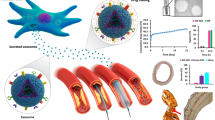Abstract.
Cationic liposomes/DNA complexes are widely used vectors for delivering genes in clinical and experimental trials. Relatively low transfer efficiencies in vivo compared with viral gene transfer may be improved using local application. In addition, markedly increased transfer efficiency may be achieved in vitro and in vivo via optimization of known variables influencing liposomal transfection. Lipofection under different conditions was performed in various cell lines and primary porcine smooth muscle cells. Optimized conditions found in vitro were verified in vivo using a porcine restenosis model. Toxicity was monitored analyzing cell metabolism. Transfer efficiency and safety were determined using morphometry, histology, galactosidase assays, PCR, and RT-PCR. The most important variables enabling maximum transfer efficiency were firstly the appropriate selection of cationic lipids for the cell type to be transfected, secondly the DNA/liposome ratio chosen, which depended on the cell type and cationic lipids used, and thirdly the state of proliferation of the targeted cells. Transfection in vivo demonstrated two- to fivefold higher transfer efficiencies when transfer conditions were extrapolated from optimization experiments in stationary cells compared with the use of conditions established in proliferating cells. Application of the therapeutic gene for cecropin using optimized transfer conditions resulted in a significantly reduced neointima formation compared with the transfection using a control gene for ß-galactosidase. Thus, in this vascular model, initial optimization of lipofection in stationary cells in culture followed by local delivery in vivo and with selection of a suitable therapeutic gene led to markedly improved transfer efficiencies, gene expression, and biological effect. Stationary cell cultures simulate more realistically the in vivo situation and may therefore represent a better model for future in vivo experiments. In addition, the advantages of liposomes are easy handling, low toxicity, and the lack of carcinogenicity or immunogenic reactions.
Similar content being viewed by others
Author information
Authors and Affiliations
Additional information
Electronic Publication
Rights and permissions
About this article
Cite this article
Pelisek, J., Engelmann, M.G., Golda, A. et al. Optimization of nonviral transfection: variables influencing liposome-mediated gene transfer in proliferating vs. quiescent cells in culture and in vivo using a porcine restenosis model. J Mol Med 80, 724–736 (2002). https://doi.org/10.1007/s00109-002-0368-9
Received:
Accepted:
Issue Date:
DOI: https://doi.org/10.1007/s00109-002-0368-9




